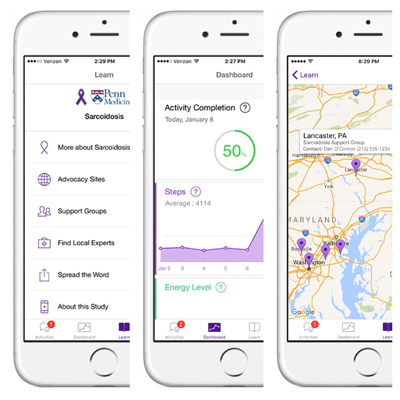 In a first for the University of Pennsylvania Health System, Penn Medicine launched a new ResearchKit app today aimed at people with a rare condition called sarcoidosis, which is characterized by inflammation to one or multiple parts of the body including eyes, skin, lungs, heart, brain and other organs.
In a first for the University of Pennsylvania Health System, Penn Medicine launched a new ResearchKit app today aimed at people with a rare condition called sarcoidosis, which is characterized by inflammation to one or multiple parts of the body including eyes, skin, lungs, heart, brain and other organs.
Called simply Sarcoidosis, the app combines patient resources with research, providing people with sarcoidosis with links to disease information, advocacy groups and specialists in their region (via their smartphone’s GPS). Additionally, those using the app have the option of participating in a research study in the form of surveys about their symptoms, disease management plans and how sarcoidosis affects their lives. By marrying this information with data already captured from iPhone sensors, such as weather, geographic location and physical activity, researchers may be able to spot trends in the disease.
“This is Penn’s first foray into mobile app research,” Dr. Misha Rosenbach, assistant professor of dermatology at Penn Medicine and co-developer of the app told MobiHealthNews in an interview. “Part one is to help patients, and part two is to learn more about the disease by surveying patients. We’re using this as a proof-of-concept to see if we can use an app to support rare disease resource and support.”
The idea for the app came about relatively naturally, said Rosenbach, who developed the app with Penn Medical student Daniel O’Connor. Working with many patients with rare diseases, Rosenbach noticed how little information both they and researchers had access to.
“I thought, everyone has a smartphone, there should be an app where people can learn about a rare condition, participate in surveys and help connect everyone who wants to know more about it,” Rosenbach said. “Dan, who has a background in programming, was literally standing right behind me and said, ‘I think we can do that right now.’”
Along with Albany Medical Center’s Dr. March Judson and the Foundation for Sarcoidoisis, Rosenbach and O’Connor went to work developing the app, which was also supported with private donations from patients with sarcoidosis. Rosenbach, who also edits the patient information page JAMA dermatology, writes the content for the app in a way the average person can easily understand, citing the current difficulty in accessing information that is, at best, only decipherable to a scientist and at worst, inaccurate.
“I take care of a lot of patients with relatively rare diseases, and I hear very often that I am the fifth or sixth doctor they’ve seen, that nobody knows what’s going on and so they send them to us,” Rosenbach said. “And there is the thinking that with the internet, they’d be able to find a lot of information, but as we know, a lot of misinformation or even fake information is out there, and what accurate research is out there is not approachable to the average person.”
While also providing patients with usable information and support, the Sarcoidosis app has the potential to offer study opportunities on a scale that hasn’t been previously possible. Like many rare diseases, sarcoidosis is hard to conduct large studies on (it affects about 10 to 30 Americans out of 100,000 each year). The largest study to date had 800 patients, conducted over a three-year-period across 20 medical centers in the United States, and even that didn’t answer many questions about the disease, such as how it impacts one’s daily life. Since the disease affects people differently and can be triggered by a variety of factors, Rosenbach said research that can happen on a granular level through an app could be very useful.
“We still don’t know a lot of fundamental basics of the disease, like how are your symptoms today versus yesterday? How much activity did you do?” said Rosenbach. “Then we can pair that with the air quality index or other factors and start learning more about what causes flare-ups.”
People with rare diseases have to deal with not only a lack of understanding from most people around them, but relatively few treatment options as pharmaceutical research and development is slow for conditions that don’t affect many people. So Rosenbach hopes this potentially large-scale research opportunity can address some of those pain points.
“With sarcoidosis, it manifests itself in a lot of ways, and because it can be on the face or their eyes and their skin, much of it has psychosocial implications, where it affects their relationships, their day-to-day work, and the treatment also has a lot of side effects,” he said. “If you have the potential for everyone to get onboard with an app, suddenly you have great power to understand more.”
While the app was designed to be very bare bones at the outset in order to stay in-line with the IRB process and ensure data protection and privacy, they are looking at incorporating new tools into the app as they get more participants and researchers signed on. Since Rosenbach is dealing with patients who are often frustrated with the lack of research and support due to the rarity of their condition, he said many come to him already motivated to participate in a study.
“It’s really hard to find people with rare diseases so you can conduct studies, but with mobile devices, we can start find thousands of patients and become better advocates for that patient population,” said Rosenbach. “In my situation, patients are very familiar with participating because it is very empowering for them to tell you what it is like to have their disease.”

















